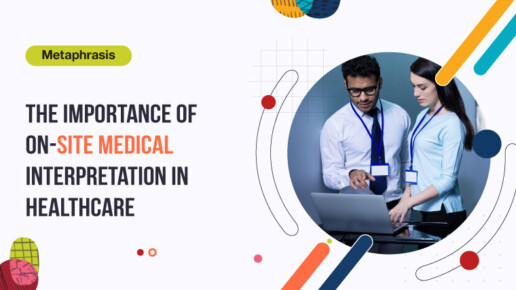The Importance of On-Site Medical Interpretation in Healthcare
Introduction
In the intricate world of healthcare, effective communication is paramount. One crucial aspect often overlooked is the role of on-site medical interpretation. In this blog, we’ll delve into the significance of this practice and how it contributes to enhanced patient care.
What is On-Site Medical Interpretation?
At its core, on-site medical interpretation involves having trained Professional interpreters physically present to facilitate communication between healthcare providers and patients who speak different languages. This ensures accurate transmission of crucial information, fostering a deeper understanding of medical conditions and treatment options.
The Impact on Patient Care
The undeniable link between effective communication and quality healthcare is exemplified through on-site medical interpretation. By bridging language gaps, it not only prevents misunderstandings but also promotes patient engagement, leading to better health outcomes.
Breaking Language Barriers
In the diverse landscape of healthcare, language barriers can impede the delivery of optimal care. On-site medical interpreters play a pivotal role in breaking down these barriers, addressing the perplexity surrounding linguistic diversity in healthcare settings.
Benefits for Healthcare Providers
Beyond aiding patients, on-site interpretation offers substantial benefits to healthcare providers. Improved communication leads to more accurate diagnoses, streamlined treatment plans, and ultimately, greater overall efficiency in medical practice.
Ensuring Cultural Competence
Language is just one facet of effective communication. Cultural sensitivity is equally vital. On-site medical interpretation ensures that healthcare providers not only understand the words spoken but also grasp the cultural nuances that can impact medical decisions.
How On-Site Interpretation Works
The mechanics of on-site interpretation involve skilled professionals who serve as intermediaries, facilitating dialogue between healthcare professionals and patients. This human touch is invaluable in conveying empathy and understanding in the medical context.
Overcoming Challenges
Despite its benefits, on-site interpretation faces challenges such as logistical issues and the need for a diverse pool of interpreters. Addressing these challenges is crucial for the widespread implementation of this essential service.
Cost-Effectiveness
While the upfront costs of on-site interpreting may seem significant, the long-term savings are undeniable. Effective communication reduces the likelihood of medical errors, unnecessary tests, and hospital readmissions, ultimately benefiting the healthcare system as a whole.
Technological Advancements
The integration of technology in medical interpretation is transforming the landscape. Video and telephonic interpretation services are gaining prominence, providing flexibility while maintaining the essential human connection.
The Human Touch
In the digital age, maintaining the human touch in healthcare is vital. On-site interpretation ensures that amidst technological advancements, the empathy and understanding conveyed through personal interactions remain integral to medical practice.
Legal and Ethical Considerations
Compliance with regulations is paramount in healthcare. On-site interpreters must adhere to legal and ethical standards, protecting patient confidentiality and ensuring that interpretation services align with industry guidelines.
Training and Certification
To guarantee the quality of on-site interpretation, rigorous training and certification programs are essential. Healthcare institutions must invest in the professional development of interpreters to uphold the standards of this critical service.
Real-Life Success Stories
Numerous success stories highlight the positive impact of on-site medical interpretation on patient outcomes. These anecdotes underscore the tangible difference that effective communication can make in the healthcare journey.
Future Trends
As the healthcare landscape evolves, so does the field of medical interpretation. Anticipating future trends, including increased reliance on technology and ongoing efforts to improve cultural competence, is vital for staying at the forefront of healthcare communication.
Conclusion
In conclusion, on-site medical interpretation stands as a cornerstone in achieving effective communication within healthcare settings. Beyond breaking language barriers, it fosters a deeper connection between healthcare providers and patients, ultimately leading to improved outcomes and a more patient-centric approach to medical care.

